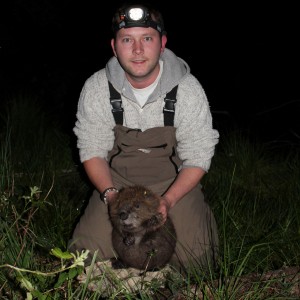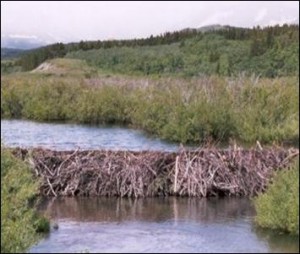Quantifying the influence of Beaver (Castor fiber) activities on fish
As the topic of beaver (Castor fiber) reintroduction continues to gain momentum, ICER researchers are currently investigating the potential impacts of beaver activities on fish. Beaver dams can form temporal barriers to fish movement when flows are low, possibly inhibiting direct passage to the spawning grounds for some fish, which is a concern particularly for those that represent the interests of salmonid fisheries.
Currently, ICER researchers are focusing on the ability of migrating brown trout (Salmo trutta) to pass beaver dams in both the up- and downstream direction. Using Passive Integrated Transponder (PIT) tag technology, tagged trout can be detected approaching monitored beaver dams. As a result, the ability of the trout to pass the dams can be quantified. The time spent negotiating the dams is recorded allowing the extent to which migration may be delayed to be better understood.
Further, the ICER team are comparing beaver modified habitats with that which represents a reference or unmodified river. As part of this element, differences in species composition and abundance will be assessed.
This research is funded by Scottish Natural Heritage, The Game and Wildlife Conservancy Trust, The Salmon and Trout Association, and RCUK.
People:
Robert Needham
A critical review of the effects of beavers on fish and fish stocks
 Scottish Natural Heritage (SNH), in collaboration with specialists based across Europe and the UK and with full national consultation, has conducted an extensive assessment of the feasibility and desirability of reintroducing the European beaver (Castor fiber) to Scotland. This accords with UK Government obligations to consider the desirability of reintroducing certain extinct species under Article 22 of the European Council Directive 92/43/EEC on the Conservation of Natural Habitats and of Wild Flora and Fauna (the ‘Habitats Directive’). The European beaver became extinct in Scotland as a result of over-hunting around the 16th Century. Further, the European beaver is one of 32 species included in Scotland’s “Species Action Framework” as a focus of new management action for five years from 2007 for SNH and a range of partners. The Species Action Framework, launched in 2007 by Ministers, sets out a strategic approach to species management in Scotland.
Scottish Natural Heritage (SNH), in collaboration with specialists based across Europe and the UK and with full national consultation, has conducted an extensive assessment of the feasibility and desirability of reintroducing the European beaver (Castor fiber) to Scotland. This accords with UK Government obligations to consider the desirability of reintroducing certain extinct species under Article 22 of the European Council Directive 92/43/EEC on the Conservation of Natural Habitats and of Wild Flora and Fauna (the ‘Habitats Directive’). The European beaver became extinct in Scotland as a result of over-hunting around the 16th Century. Further, the European beaver is one of 32 species included in Scotland’s “Species Action Framework” as a focus of new management action for five years from 2007 for SNH and a range of partners. The Species Action Framework, launched in 2007 by Ministers, sets out a strategic approach to species management in Scotland.
As a result of the findings of the feasibility and desirability studies, a trial reintroduction of up to four families of European beaver to Knapdale Forest, Argyll, by the Scottish Wildlife Trust (SWT) and the Royal Zoological Society of Scotland (RZSS) on behalf of the ‘Scottish Beaver Trial’ partnership was sanctioned by the Minister of the Environment in 2008. The trial aims to conduct a five year robustly monitored reintroduction which will facilitate decision makers tasked with considering the feasibility and desirability of reintroducing European beaver to the whole of Scotland. Once the trial has been completed, SNH will provide a final report to the Scottish Government.
However, plans to conduct a trial reintroduction of European beaver to Scotland have been the subject of much debate. National and local public consultation exercises conducted since 1998 indicate that the majority support the plans, but some individuals and key stakeholder groups (e.g. some of those representing fisheries interests) maintain reservations and continue to raise concerns. Therefore a report by members of ICER provided an independent critical review, based on scientific literature and expert opinion, of the impacts of beaver on fish and fish stocks, and collated new, updated information which can be used in the wider consideration of beaver reintroduction to Scotland.
Recent Relevant Articles: Here
Also, here is the work conducted by the Beaver-Salmonid Working Group (BSWG):
And a link to the video of a presentation by Dr Paul Kemp:
“Review of the Effects of Beaver on Fish and Fisheries”
People:
Dr Paul Kemp
Dr Tom Worthington
Professor Terry Langford
